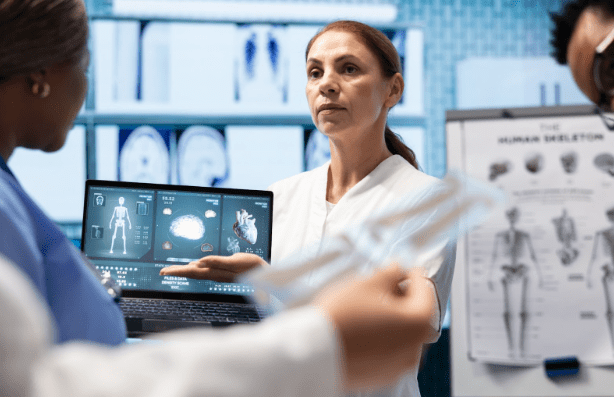America’s healthcare system has some issues, there’s no doubt about it. Even for those lucky enough to have health insurance via their employer, there are still accessibility issues, denial of coverage, and out-of-pocket expenses. A simple hospital visit has the potential to bankrupt families if they’re not covered for some or all of the visits. The healthcare industry needs not just incremental fixes but transformative change. Technology has the potential to be part of the solution. This article will touch on issues within America’s healthcare system before exploring how technology (such as AI) can help to improve the U.S. healthcare system.
What Are the Issues With America’s Healthcare System?
As we’ve alluded to above, a major issue with America’s healthcare system is that it is privatized. There is minimal universal healthcare, unlike other developed nations. Healthcare access is gated behind having adequate insurance coverage, and even for those that have health coverage, there are still gap payments, out-of-pocket expenses and denial of coverage for accidents, illness and hospital treatment. These issues have come to light in recent times, with intense news coverage of the inequalities in the healthcare system within the USA.
How Can Technology Help Heal This System?
The rest of this article will address how technology, including AI, can help remedy the problems that surround the healthcare system in the USA. Whether it’s growing the workforce by encouraging more students to undertake BSN to MSN programs online or implementing widespread use of AI in healthcare settings, technology has the power to facilitate transformative change. Let’s explore this in some more detail in the following sections of this article.
Digital and Remote Treatment
One major innovation that the world saw emerge out of the global COVID-19 pandemic that has permanently changed the healthcare landscape was telehealth or video consultations. Telehealth is where a patient can consult with a doctor or other healthcare provider from the comfort of their own home, using technology such as video conferencing or a simple phone call. The sheer necessity of preventative lockdown measures made this possible throughout 2020-2021, as people were encouraged or required to stay home and healthcare providers were inundated with COVID-19 cases, making treating basic issues more difficult.
We’re likely to see a steady increase in the use of telehealth and remote treatment technologies in the next decade or so, and this is a win for healthcare accessibility and the healthcare system in the USA. Those living in remote and rural locations will be able to access specialists to treat serious health conditions and diseases, and it is also a boon for those living with crippling mental health problems that can prevent them from leaving the house, such as agoraphobia. These people can access treatment that would otherwise be unavailable to them.
Of course, when it comes to physical treatment, these folks may still have to travel, but for general appointments or getting prescriptions, this can all be done remotely via a computer or the telephone.

Digital Technology and Healthcare
One of the highest-impact trends in healthcare technology over the next decade or two will be a rapid acceleration in the digital transformation of medicine and primary healthcare. This goes far beyond the telehealth or video consultations that we just mentioned, as digital tools will utterly transform the healthcare landscape.
This digital transformation will see trends emerge that could help heal America’s healthcare system, such as hospital treatment at home, health and wellbeing apps, and remote monitors, including vital sign monitoring, blood sugar, and other monitoring. Certain vital health metrics such as cardiac rhythm, weight, blood pressure, and blood glucose can be monitored remotely via wearable devices that feed these metrics straight to healthcare providers’ software via Bluetooth and the web. This tech will likely evolve beyond current devices such as smartwatches. It will involve devices that are directly woven into clothes, or sensors placed on certain areas of the body, and even monitoring implants.
In addition to this, significant investment is being made in new medical-grade sensor technology, cloud computing for healthcare providers, and advanced data analytics programs. Data analytics is an important innovation because high-quality data leads to customized, tailored healthcare, which will cut costs of both healthcare provision and insurance policy premiums, making healthcare more affordable in America.
Over the last few years, some digital initiatives have been a critical driver in the increase in USA healthcare investment, with digital health startup companies making up to forty percent of fundraising rounds and seed funding. As new technology emerges, the cost of healthcare will continue to decrease, and we’ll see how tech can help heal the industry in the USA.
AI’s Role in Healing the Healthcare System
The advent of AI has shaken the world, with major tech giants investing heavily in generative AI to boost productivity and assist workers.
For instance, AI can help to augment labor shortages by analyzing where medical staff are needed most and then allocating medical resources effectively and efficiently, so staff can be deployed in disease hot spots or when outbreaks occur. This would effectively function as a traditional triage system but in overdrive. AI could direct physicians working in hospitals to where they’re needed the most, and not just based on walk-in assessments and episodic care, but driven by a deep understanding and analysis of a patient’s data as a whole. It would also use advanced statistical and trend analysis for higher levels of predictive and preventive healthcare.
Furthermore, AI can also streamline administrative processes such as clinical documentation review and billing. These admin processes tend to consume a disproportionate amount of doctors’ time, with one recent study finding physicians spent nearly 50% of their time manually updating electronic health records. By automating these administrative tasks, AI can allow primary healthcare workers to focus more on direct patient care rather than wasting time getting slowed down by data entry.
AI and Mental Healthcare
AI can also assist America’s mental health care system. One way that some therapists are embracing AI is by the use of chatbots. You’re probably already familiar with chatbots from shopping online or accessing a company’s customer service via automated web chat. The premise here is the same, but in this case, the AI chatbots are focused on supporting someone with mental health issues. These chatbots can be free and are an excellent first point of contact when someone seeks support for their mental health issues. Free support can go a long way to healing America’s mental health sector. In addition to making mental health support more affordable (or even free) and accessible for everyone, chatbots can assist those people who may stay away from a human therapist, such as people newer to therapy or people experiencing social anxiety or agoraphobia.
For those concerned about entrusting their mental health care to an AI chatbot, you’ll be pleasantly surprised to hear about the advent of the Wysa chatbot. This chatbot does not use generative AI but instead limits its interactions to statements that were either drafted or approved by real human therapists. Wysa does not collect personal data or contact details, and it also redacts information users share that could potentially identify them.

